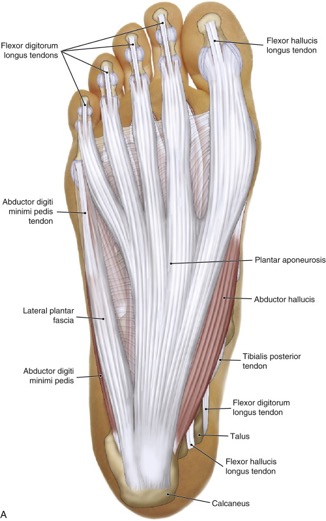Introduction to plantar fasciitis:
Plantar fasciitis is a condition in which the plantar fascia (plantar aponeurosis) of the foot becomes irritated and inflamed.
Note: Heel spur, which usually occurs as a consequence of plantar fasciitis, is marked by the presence of a bone spur off the distal/plantar surface of the calcaneus.

Plantar view of the foot. Permission: Joseph E. Muscolino. The Muscle and Bone Palpation Manual, 2ed (2016) Elsevier.
The plantar fascia is a thick layer of fibrous fascia that is located on the plantar surface of the foot and attaches from the tuberosity of the calcaneus proximally to the flexor sheathes of all five toes distally. The plantar fascia functions to stabilize the foot and maintain the arch-structure (supination) of the foot. When the foot is loaded during weight bearing, the arch drops (termed pronation) and the plantar fascia stretches. As the foot is unloaded, the plantar fascia acts like a spring and elastically recoils to reform the arch and supinate the foot. Pronation and supination are natural motions of the foot that occur whenever we walk (the gait cycle) or run.
All three muscles of the first (most superficial) layer of plantar intrinsic musculature attach into the plantar fascia; these muscles are the abductor hallucis on the big toe side, the abductor digiti minimi pedis on the little toe side, and the flexor digitorum brevis located between the other two.
Causes:
The major cause of plantar fasciitis is overuse coupled with poor biomechanics of the foot, most commonly excessive foot pronation (pes planus). As stated, pronation places a pulling (tensile) force on the plantar fascia. If these tensile forces produced during pronation are excessive, the plantar fascia can become irritated and inflamed. Plantar fasciitis can also occur in a client/patient who has a healthy arch if the client/patient spends a great deal of time weight bearing. Coupling overpronation with a lot of time weight bearing is a prescription for plantar fasciitis.
The physical stress on the plantar fascia is increased if the client/patient spends a lot of time standing on hard surfaces, wears stiff shoes/boots, high-heeled shoes, shoes that have too high of an arch, or if the client/patient is overweight or pregnant (plantar fasciitis is also exacerbated during pregnancy due to the release of the hormone relaxin). A sudden change in activity level also increases the risk of developing plantar fasciitis. New recruits in the military and recreational athletes who begin training overzealously are at high risk. Given that overpronation is the primary cause of plantar fasciitis, any factor that causes or contributes to overpronation is therefore also a contributor to plantar fasciitis.
An excessively high arch (pes cavus) is also a precipitating factor for plantar fasciitis because high arches do not offer the needed spring-like elongation that helps to absorb the shock of weight bearing. With a high arch, the plantar fascia is chronic taut, predisposing it to irritation and inflammation. Another cause of plantar fasciitis is compression force against the plantar fascia. This can be caused by a blunt macrotrauma to the underside of the foot, for example jumping and landing on a hard surface such as a rock.


